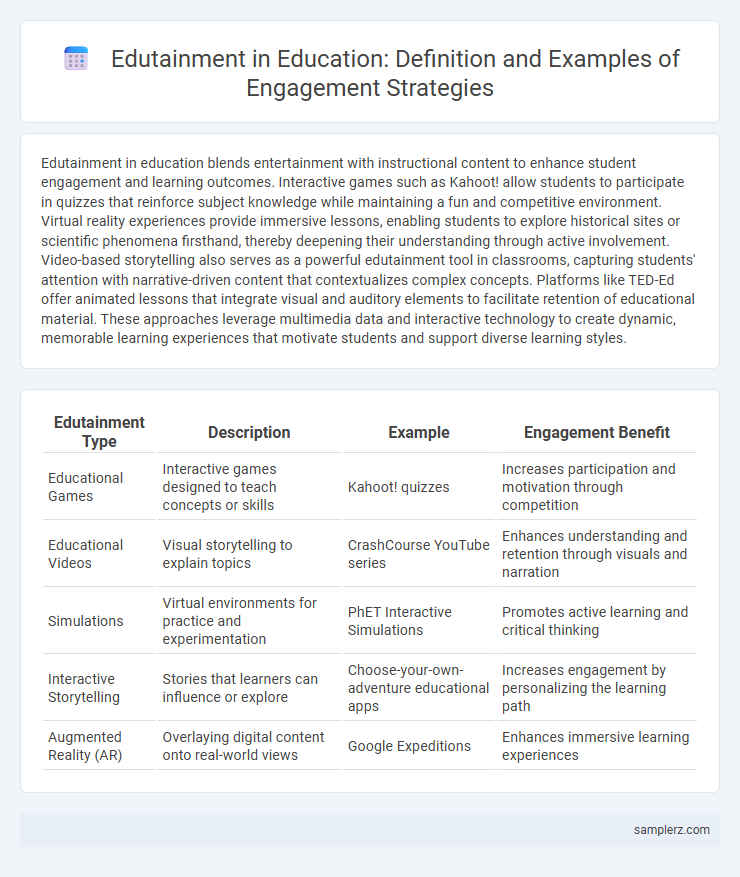Edutainment in education blends entertainment with instructional content to enhance student engagement and learning outcomes. Interactive games such as Kahoot! allow students to participate in quizzes that reinforce subject knowledge while maintaining a fun and competitive environment. Virtual reality experiences provide immersive lessons, enabling students to explore historical sites or scientific phenomena firsthand, thereby deepening their understanding through active involvement. Video-based storytelling also serves as a powerful edutainment tool in classrooms, capturing students' attention with narrative-driven content that contextualizes complex concepts. Platforms like TED-Ed offer animated lessons that integrate visual and auditory elements to facilitate retention of educational material. These approaches leverage multimedia data and interactive technology to create dynamic, memorable learning experiences that motivate students and support diverse learning styles.
Table of Comparison
| Edutainment Type | Description | Example | Engagement Benefit |
|---|---|---|---|
| Educational Games | Interactive games designed to teach concepts or skills | Kahoot! quizzes | Increases participation and motivation through competition |
| Educational Videos | Visual storytelling to explain topics | CrashCourse YouTube series | Enhances understanding and retention through visuals and narration |
| Simulations | Virtual environments for practice and experimentation | PhET Interactive Simulations | Promotes active learning and critical thinking |
| Interactive Storytelling | Stories that learners can influence or explore | Choose-your-own-adventure educational apps | Increases engagement by personalizing the learning path |
| Augmented Reality (AR) | Overlaying digital content onto real-world views | Google Expeditions | Enhances immersive learning experiences |
Interactive Learning Games for Classroom Engagement
Interactive learning games enhance classroom engagement by promoting active participation and immediate feedback, which improves knowledge retention and critical thinking skills. These games incorporate multimedia elements and adaptive challenges tailored to diverse learning styles, fostering motivation and collaboration among students. Research shows that interactive gamified education increases attention spans and encourages problem-solving, making it an effective tool for modern classrooms.
Gamified Assessments as Edutainment Tools
Gamified assessments leverage game mechanics like points, badges, and leaderboards to enhance student engagement and motivation in learning environments. These interactive tools transform traditional testing into immersive experiences, increasing focus and retention by incorporating challenges and instant feedback. Research shows that gamified assessments improve cognitive engagement and foster a positive attitude towards learning by combining education with entertainment.
Virtual Reality Experiences in Education
Virtual Reality experiences in education transform learning environments by immersing students in interactive, three-dimensional simulations that enhance engagement and focus. These VR applications enable learners to explore complex subjects such as anatomy, history, or physics through hands-on virtual labs and realistic scenarios, making abstract concepts more tangible. Research indicates that VR-based edutainment can improve retention rates by up to 30% compared to traditional instructional methods, supporting deeper cognitive processing and sustained attention.
Storytelling Methods for Active Participation
Storytelling methods for active participation in education significantly enhance student engagement and focus by integrating narratives that relate to real-life scenarios, fostering empathy and critical thinking. Interactive story-based activities, such as role-playing and choose-your-own-adventure frameworks, create immersive learning experiences that promote collaboration and maintain attention. These techniques leverage multimedia tools and gamified elements to stimulate cognitive involvement, making complex concepts more accessible and memorable.
Edutainment Apps Enhancing Student Motivation
Edutainment apps like Kahoot!, Duolingo, and Quizlet blend interactive gameplay with curriculum content to significantly boost student motivation and engagement. These platforms leverage gamification techniques such as points, badges, and leaderboards, fostering a competitive yet educational environment that enhances focus and retention. Research indicates that students using edutainment apps demonstrate higher levels of active participation and improved learning outcomes compared to traditional methods.
Educational Videos That Promote Student Involvement
Educational videos that promote student involvement integrate interactive elements such as quizzes, polls, and real-time feedback to enhance engagement and retention. Platforms like Khan Academy and TED-Ed use storytelling combined with multimedia to make complex concepts accessible and captivating. These videos foster active learning by encouraging critical thinking and collaboration among students.
Digital Simulations for Real-World Problem Solving
Digital simulations in education engage students by providing immersive, interactive environments that mimic real-world scenarios, enhancing problem-solving skills and critical thinking. These tools allow learners to experiment with variables and observe outcomes in a risk-free setting, improving retention and application of complex concepts. Research shows that integrating digital simulations increases student motivation and deepens understanding in STEM subjects and vocational training.
Collaborative Online Platforms for Fun Learning
Collaborative online platforms like Kahoot! and Quizlet foster engagement by integrating gamified quizzes and interactive flashcards, enhancing focus through competitive and cooperative learning experiences. These platforms utilize real-time feedback and social interaction to motivate students, making education enjoyable while improving retention. Leveraging multimedia elements such as videos and animations further supports diverse learning styles, promoting active participation and deeper understanding.
Creative Use of Social Media in Learning Activities
Creative use of social media in learning activities, such as interactive Instagram challenges or TikTok science experiments, significantly boosts student engagement and focus by providing relatable and visually stimulating content. Platforms like YouTube and Twitter facilitate collaborative learning through live discussions, video tutorials, and real-time feedback, enhancing knowledge retention. Integrating social media tools into lessons leverages familiar digital environments to motivate active participation and foster a dynamic educational experience.
Outdoor Edutainment Activities for Experiential Learning
Outdoor edutainment activities such as interactive nature trails, scavenger hunts, and adventure-based learning games significantly boost student engagement and focus by combining physical activity with educational content. These experiential learning methods promote hands-on discovery, critical thinking, and collaboration, making complex concepts more relatable and memorable. Studies show that immersive outdoor experiences enhance knowledge retention and improve students' attention spans compared to traditional classroom settings.

example of edutainment in engagement Infographic
 samplerz.com
samplerz.com